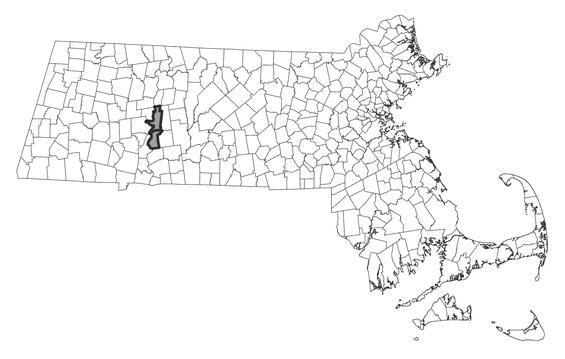- Scientific name: Nuphar microphylla
- Species of Greatest Conservation Need (MA State Wildlife Action Plan)
- Endangered (MA Endangered Species Act)
Description
The tiny cow-lily (Nuphar microphylla) is a perennial aquatic herb of the Nymphaeaceae family. Like other species of water-lily, its leaves float on the surface of slow-moving or still waters. The oblong leaves are notched at the base and are pinnately veined (with a distinct central mid-vein). They have very long petioles which connect to a horizontal stem, called a rhizome, running beneath the substrate of the pond or stream-bottom. Golden-yellow flowers, similar to those of the common spatterdock (or yellow water-lily), but smaller, float at the water’s surface from mid-June through August.
The species most likely to be confused with the tiny cow-lily in Massachusetts is spatterdock (Nuphar variegata). Tiny cow-lily has smaller leaves than spatterdock; while the size ranges do overlap, the leaves are always less than 20 cm (8 in) long and less than 14.5 cm (6 in) wide in the tiny cow-lily. In addition, the tiny cow-lily has smaller flowers, and the “stigmatic disc” (a flat structure of radiating stigmas in the flower’s center) is red and deeply lobed. In contrast, spatterdock has larger flowers with a yellowish green and unlobed or very shallowly-lobed stigmatic disk. Spatterdock and tiny cow-lily do hybridize, and the hybrid is named Nuphar x rubrodisca, after the reddish tinge the stigmatic disc takes on from its tiny cow-lily parentage. True tiny cow-lily may be discerned from this hybrid by its smaller flower size (2 cm or less (0.8 in) wide, compared to 3 cm or more (1.2 in) wide in the hybrid) and relative length of the notch in the leaf base (notch a third or less the length of the midrib in tiny cow lily, compared to half the length of the midrib in the hybrid).
Life cycle and behavior
This is a perennial species.
Population status
Tiny cow-lily is listed as endangered under the Massachusetts Endangered Species Act. All listed species are protected from killing, collecting, possessing or sale and from activities that would destroy habitat and thus directly or indirectly cause mortality or disrupt critical behaviors. The Massachusetts Natural Heritage & Endangered Species Program has 12 records from 4 counties: Berkshire, Hampshire, Middlesex, and Worcester. 2 of these records have been observed within the last 25 years.
Distribution and abundance
Tiny cow-lily is a species of northeastern North America; it ranges from Nova Scotia and New Brunswick west to Manitoba, south to New Jersey and Minnesota.

Distribution in Massachusetts
1999-2024
Based on records in the Natural Heritage Database
Habitat
In Massachusetts, tiny cow-lily is found in shallow, still or slow-moving waters that are not acidic. Recently, it has been observed growing in oxbows, coves and backwaters of rivers in association with water starwort (Heteranthera dubia), long-leaved pondweed (Potamogeton nodosus), ribbon-leaf pondweed (P. epihydrus), wild celery (Vallisneria americana), water crowfoot (Ranunculus aquatilis) and several invasive exotic species noted below. Historically it has been known from ponds in Massachusetts, and it is expected that it will be rediscovered in pond habitat.
Healthy habitats are vital for supporting native wildlife and plants. Explore habitats and learn about conservation and restoration in Massachusetts.
Threats
The invasive exotic species Eurasian water-milfoil (Myriophyllum spicatum), curly-leaved pondweed (Potamogeton crispus), fanwort (Cabomba caroliniana), and water-chestnut (Trapa natans) have been reported to co-exist with the remaining populations of tiny cow-lily and may be competing with it for resources. Ironically, broad-spectrum herbicide application to control aquatic weeds could also threaten this species. Other potential threats to the remaining population include habitat alteration by beaver and from road run-off.
Conservation
Hand-pulling of aquatic invasive species is recommended around populations of rare aquatic species.
Contact
| Date published: | May 6, 2025 |
|---|